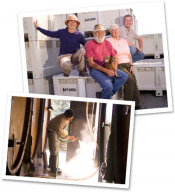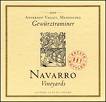 This little tale of winery economics out of Mendocino County’s Anderson Valley is about sparing no expense in the pursuit of getting the wine just the way you want it. The story, almost hidden in a small item in the ‘Navarro Vineyards Holiday 2006 Newsletter,’ began late in 2005 at the winery and, after a trip halfway around the world, ends there several months later.
This little tale of winery economics out of Mendocino County’s Anderson Valley is about sparing no expense in the pursuit of getting the wine just the way you want it. The story, almost hidden in a small item in the ‘Navarro Vineyards Holiday 2006 Newsletter,’ began late in 2005 at the winery and, after a trip halfway around the world, ends there several months later.
During a walk-through of the winery, checking the progress of various fermentations, the cellar crew noticed something unusual about the appearance of one of the Navarro 1400-gallon French oak ovals, holding fermenting Pinot Gris.
Observing a traditional practice in the Alsace region of France, Navarro ferments all of its Alsatian varieties — Riesling, Gewurztraminer, Muscat and Pinot Gris — in oak ovals instead of the more common California practice of fermentation in temperature-controlled stainless steel tanks for these fruity whites.
More important than the Alsace connection, though, is belief that the ovals are essential to Navarro for fermenting the Alsatian white varieties. ‘We found a big difference between fermenting Pinot Gris and the other Alsatian white wines in a stainless steel tank and an oak oval; we get more lees contact in the ovals and that makes a difference in the style of Pinot Gris we make,’ explains Ted Bennett, who with his wife, Deborah Cahn, own Navarro Vineyards, one of California’s foremost specialists in making fruity aromatic white wines.
The heads on oak ovals are not flat but slightly concave, adding strength to the overall integrity of the tank. But the head on the suspect oval was bowed, which meant a point of weakness in the vat, with the possibility that the whole thing might begin to leak or even blow.
‘We didn’t know what was wrong but thought it could be that the head was too thin and the pressure of the wine was forcing it outwards,’ says Bennett.
So he contacted Picard cooperage in Burgundy, France, explained the problem and (this is where the story gets amazing), ‘Picard suggested the oval be returned to the cooperage for repairs.’
 Workers loaded the damaged oval onto a flat bed truck, hauled it to the Port of Oakland, hoisted the empty vat onto a ship and carried it on a long sea and land journey halfway around the world to Tonnellerie Picard in Burgundy. Several months later, the restored oval was back in service in the cellars of Navarro Vineyards.
Workers loaded the damaged oval onto a flat bed truck, hauled it to the Port of Oakland, hoisted the empty vat onto a ship and carried it on a long sea and land journey halfway around the world to Tonnellerie Picard in Burgundy. Several months later, the restored oval was back in service in the cellars of Navarro Vineyards.
Why not have the barrel repaired by a California cooper, I asked? ‘Picard wanted to make it right,’ replied Bennett.
OK, but I still couldn’t get my head around this decision that seemed to me outrageously expensive, so I asked Bennett, ‘Wouldn’t it have been less expensive to buy a new oval tank?’
He threw it back to me with a laugh; ‘Do you know how much a new oval costs?’ Sensing that as far as Bennett was concerned, this was a no-brainer, I lamely mumbled, ‘Well, ah…no.’
‘$20,000 a piece!’ he yelled.
To quote the few words Navarro lent to this little cautionary tale, ‘few obstacles are too daunting in the pursuit of fine wine.’
A postscript: The Navarro Vineyards newsletter is one of the best I’ve read, a level of quality and interest that parallels their wines. You can get on the mailing list by visiting Navarro Vineyards at www.navarrowine.com.
6
